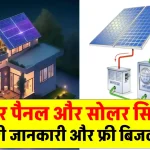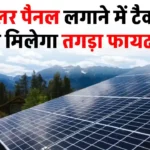
As we move deeper into 2025, more homeowners and small business owners are considering solar energy not just as an eco-conscious decision but also as a smart financial move. The shocking cost of a 2.5kW solar system in 2025 has caught the attention of many, both for how affordable it has become and for the financial risks of delaying installation. In this guide, we break down everything you need to know, from current prices to government incentives and long-term benefits.
Switching to solar has never been more affordable, thanks to technological advancements, increased competition in the solar market, and attractive government subsidies. But if you wait too long, you could miss out on huge savings. Let’s explore why now might be the best time to invest in a solar system.
Also Check: UK Households Rushing for 7kW Solar Systems – Find Out Why Before Prices Surge Again
Why the 2.5kW Solar System Is a Smart Choice in 2025
A 2.5kW solar system hits the sweet spot for many residential homes in India. It’s powerful enough to cover essential appliances like lighting, fans, a refrigerator, and even a small air conditioner for a few hours each day. Here’s why it’s becoming a popular choice:
- Compact Size: Requires less rooftop space compared to larger systems.
- Lower Upfront Cost: Makes it ideal for first-time solar adopters.
- High Efficiency: Advances in panel technology deliver more output per square foot.
According to Amplus Solar, the typical cost for a 2kW on-grid system is around ₹1,44,000. By simple extrapolation, a 2.5kW system costs around ₹1,80,000. With a 40% subsidy from the Indian government, you can bring that down to just over ₹1 lakh.
Understanding Solar Subsidies in India (2025)
The Indian Ministry of New and Renewable Energy (MNRE) offers subsidies through the National Portal for Rooftop Solar. Here are the updated benefits:
Central Financial Assistance (CFA):
- Up to 3kW: 40% subsidy
- 3kW to 10kW: 20% subsidy
You can apply directly through the National Solar Rooftop Portal.
Who Can Avail It?
- Residential homes
- Housing societies
- Apartments (common areas only)
Note: Subsidies are only available for on-grid systems connected to your local electricity provider.
Cost Breakdown: What You’re Paying For
Here’s how the approximate ₹1,80,000 price tag breaks down:
| Component | Estimated Cost |
| Solar Panels (Monocrystalline) | ₹90,000 |
| Inverter (2.5kW) | ₹30,000 |
| Mounting Structure | ₹15,000 |
| Wiring & Accessories | ₹10,000 |
| Installation Charges | ₹35,000 |
| Total | ₹1,80,000 |
After applying a 40% subsidy (₹72,000), your net investment is around ₹1,08,000.
Practical Example: Monthly Savings
Let’s assume you currently pay ₹8 per unit of electricity. A 2.5kW system generates about 300 kWh per month.
Monthly Savings: 300 units x ₹8 = ₹2,400
Annual Savings: ₹2,400 x 12 = ₹28,800
Payback Time: ₹1,08,000 / ₹28,800 ≈ 3.75 years (actual may vary with maintenance and local tariffs).
Also Check: Going Off-Grid? These 15 Innovative Energy Solutions Are Game Changers
Hidden Costs to Watch Out For
While the base price is clear, some hidden costs may arise:
- Net Metering Charges: Discoms may charge a fee for setting up bi-directional meters.
- Maintenance Contracts: Annual maintenance might cost ₹3,000-₹5,000/year.
- Battery Backup (Optional): Adding batteries can cost another ₹50,000-₹1,00,000.
Plan accordingly to avoid surprise expenses.
Environmental Impact
- CO2 Emissions Saved: A 2.5kW system can offset ~4 tons of CO2 annually.
- Equivalence: That’s like planting 65 trees every year!
Switching to solar is not just about saving money; it’s also about creating a cleaner, greener planet.
Why Waiting Could Cost You More
1. Subsidy Might Be Reduced or Withdrawn
Government subsidies are not permanent. As the solar sector matures, incentives might reduce or disappear altogether. Those who delay could lose access to the 40% subsidy.
2. Electricity Prices Are Rising
According to CEA India, electricity tariffs have increased steadily over the past decade. Solar locks in your energy cost, protecting you from hikes.
3. Solar Equipment Costs May Fluctuate
While prices have dropped significantly, global supply chain disruptions and raw material scarcity could cause temporary spikes.
4. Delaying Increases Your Carbon Footprint
Every day you rely on grid power (mostly fossil-fuel-based) adds to your environmental impact. Early adoption helps reduce greenhouse gas emissions.
How to Install a 2.5kW Solar System: Step-by-Step Guide
Step 1: Evaluate Your Energy Needs
Check your electricity bills from the last 6 months. A 2.5kW system suits homes consuming 8–10 units/day.
Step 2: Check Rooftop Suitability
Ensure 200–250 sq. ft. of shadow-free space, preferably south-facing.
Step 3: Choose a Reputable Installer
Look for MNRE-approved vendors with a good track record and reviews.
Step 4: Apply for Subsidy
Apply through the National Rooftop Solar Portal with vendor assistance.
Step 5: Install & Connect
Installation usually takes 3–5 days. Ensure net metering setup to export surplus power to the grid.
Step 6: Monitor Performance
Use mobile apps or inverter displays to track performance and savings.
FAQs
1. Is 2.5kW enough to power my home?
Yes, it can power essential devices like lights, fans, fridge, and a small AC part-time.
2. What happens during a power cut?
On-grid systems shut off during blackouts for safety. You need a hybrid system with batteries for backup.
3. How long do solar panels last?
Panels typically last 25+ years. Inverters may need replacement every 10 years.
4. Do I need batteries?
Not for on-grid systems. Batteries are only needed for backup or off-grid setups.
Also Check: Living in the Heat? These Are the Best Solar Power Systems for African Summers!








